It's actually possible to tap loads of energy from the sun at night.
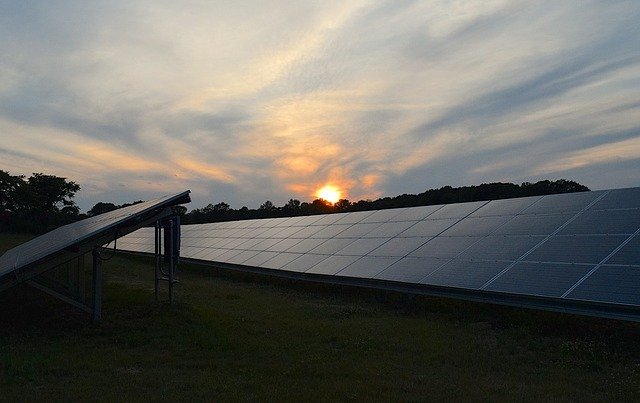 Solar panels at night
(License: Public Domain]: Pixabay
Solar panels at night
(License: Public Domain]: Pixabay Introduction
Crude oil, since its discovery in the 1880s to displace coal, has been the major source of energy in our homes and industries. However, just as coal had to step down for the emergence of crude oil, many are of the opinion that it is time for an alternative source of energy to displace crude oil; putting into perspective the negative effects of crude oil on our world today – land and water pollution, acid rain and climate change are among the many issues we are having to contend with as we continue to source for energy from crude oil.
Renewable Energy Technologies (RETs) are finally beginning to give crude oil a run for its money. Solar energy has been with us for some time now; it is one of the few, out of a number of these alternative energy sources, that is managing to get a breakthrough in a society were crude oil has been ‘king’ as far as energy is concerned.
There are many reasons why crude oil is yet to be overthrown even with the devastating negative effects it is having on our lives and environment. These RETs are simply not there yet. They all have their limitations when it comes to efficiency and cost has also been a pretty big deal. I am a big fan of these technologies though and solar energy technology happens to have the biggest prospect among them.
Current Solar Power Technologies
The earth intercepts about 173,000 Terawatts of energy from the sun; that’s around ten-thousand times the amount of energy that its population (over 7 billion people) uses. The potentials of solar energy are, simply put, limitless! Solar power technology is the use of man-made technology to harness the sun’s energy for electricity production. It is a clean and renewable source of energy. The two main solar energy technologies are Concentrating Solar Power technology (CSP) and Photovoltaic technology (PV).
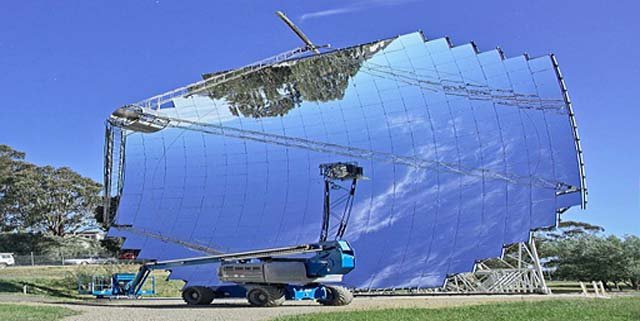 Concentrating Solar Power
(License: CC BY-SA 4.0, Author: Thennicke]: Wikicommons
Concentrating Solar Power
(License: CC BY-SA 4.0, Author: Thennicke]: Wikicommons Concentrating Solar Power (CSP) uses an indirect method of producing electricity from solar energy. Remember when you would place a small piece of mirror under the sun rays and watch as it forms a beam that burns a piece of paper placed beneath it? That’s the kind of the concept that this technology uses. It utilizes a system of mirrors to trap sunlight and then focuses the sunlight onto a receiver where it is converted to heat. The heat is then used to generate steam to run a turbine for generating electricity in a power plant. It is more commonly applied industrially.
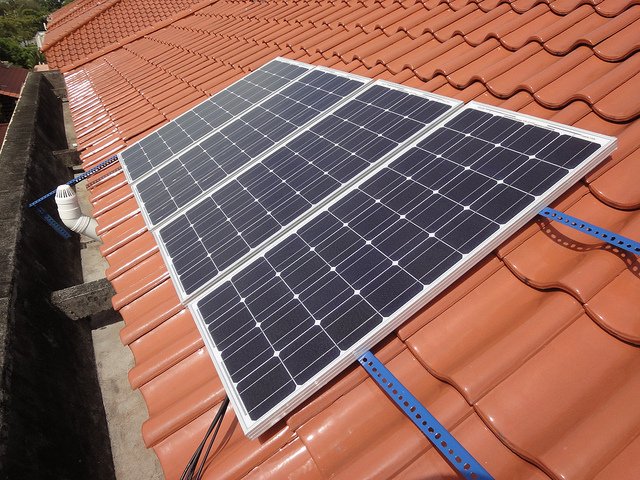 PV Arrays on residential rooftop
(License: CC BY-SA 2.0, Author: Marufish]: Flickr
PV Arrays on residential rooftop
(License: CC BY-SA 2.0, Author: Marufish]: Flickr Photovoltaic Technology (PV) is the most common form of solar power technology as it is used in solar panels which are found on residential roofs and spaces in commercial areas; the PV cells that make up a solar panel converts solar energy into electrical energy by absorbing photons of sunlight. These PV cells are made of a semi-conductor known as silicon (the second most abundant element on earth, after oxygen). In a solar cell, silicon in its crystalline form is layered between two conductive metal strips. Each silicon atom bonds covalently with 4 neighbouring atoms. The silicon in each cell has two layers; the N-type silicon and the P-type silicon which are separated by what is known as a P/N junction. When the photons of the sun light strike the PV cell, they can knock an electron from its bond, thereby leaving a free electron which goes to the N side and a hole which moves to the P side. This electron then joins other free electrons to flow through the metallic strip to an external circuit where it gets to do electrical work. The direct current (DC) that the PV produces is converted to an alternating current (AC) with the use of an inverter and this is then used for powering our home appliances.
Why we need to take a step further
Just like most other RETS, efficiency is still a major downside to this technology. Most residential solar panels still operate with an energy efficiency of 12 to 15%, that is to say, about 12 to 15% of the solar energy it receives is eventually converted to electrical energy. This is still quite far from, say, diesel engines that have an efficiency of 30 to 41%; which is why an array of solar panels would be found on the rooftop of an average residential home to supply enough power to meet the energy demands of that home. Recently, solar panels that can have up to 46% energy efficiency values are taking the leap from theoretical existence to practical reality in laboratories but they are not yet up for residential usage.
The major issue though with the common solar power technologies is currently the fact that they rely completely on the sunlight duration to function and since the earth is constantly rotating about its axis as it revolves round the sun, we have days and nights. Nights representing the time when your portion of the earth has rotated away from the light of the sun, thereby rendering solar panels useless for that period. So even if the issue of energy efficiency is taken care of, it won’t solve the biggest challenge posed to this technology which is that of energy storage. We still have to rely on batteries to store energy during the day for use during the night and on days of cloudy weather. Batteries are good for achieving this purpose; however, they do not really come cheap because of the components used to set them up. They also do not last the life-span of a typical solar panel set up, meaning; they would have to be replaced at every point in time. When you consider the exponential rate at which energy demand is increasing, you would agree that storage may not be the long-term solution. So why not just break this barrier by going to space to tap the sun’s energy continuously and without any hindrance?
SPACE-BASED SOLAR POWER (SBSP): What is night when we can have light?
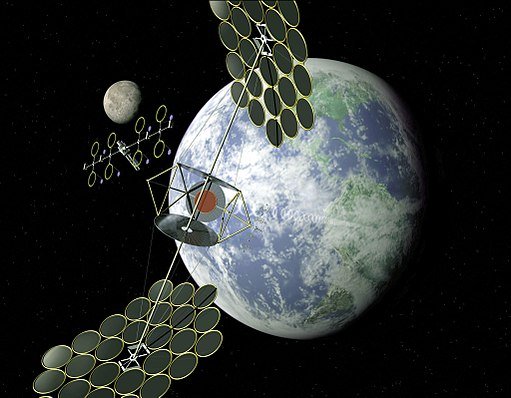 Space Based Solar Panel Technology
(License: Public Domain, Author: Nasa]: Wikicommons
Space Based Solar Panel Technology
(License: Public Domain, Author: Nasa]: Wikicommons Space-based solar power is the placing of PV system-embedded satellites in the geostationary orbit (38, 500 Km above the earth) to collect solar energy directly from the sun and transmit it wirelessly to the earth to be used as electrical energy. It intercepts sunlight in outer space and wirelessly transmits the collected energy in form of electromagnetic radiation such as microwave or laser beams to a ground receiving station on the earth’s surface. The satellite is placed in a geostationary orbit so that it could have the same rotational period as the earth and therefore prevent the transmitted waves from misaligning with the ground receiver.
This concept of SBSP was first associated with an American scientist and aerospace engineer known as Dr. Peter Glaser where it was presented in his 1968 report, Power from the Sun: Its future, for which he later received a patent in 1973. Moving on, National aerospace research institutions such as NASA of the United States and JAXA of Japan have taken strong interest in this idea and have invested a lot of resources into the Research and development of this technology which could take either of two forms;
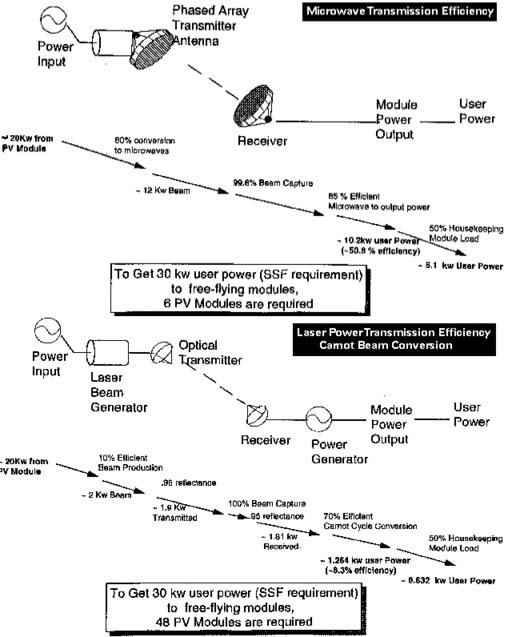 Comparison of Microwave and Laser Beam energy transmission from space
(License: Public Domain, Author: Nasa]: Wikicommons
Comparison of Microwave and Laser Beam energy transmission from space
(License: Public Domain, Author: Nasa]: Wikicommons One _ Microwave Transmission; photovoltaic arrays are coupled to a microwave power transmission system and launched as a satellite into space. It is designed in such a way that the arrays are placed facing the sun while the microwave transmission disc is aimed at a ground receiving station where the transmitted wave is then converted back to electrical energy. At the receiving station, a rectifying antenna "rectenna" is used to convert the received microwaves into electricity (DC power). The microwave rectenna is normally made up of a dipole antenna and an RF diode but for the purpose of such large scale application, it would comprise of a number of short dipole antennas that are connected to each other by diodes.
Two_ Laser Power beaming; If you are having a mental picture of lasers that split materials and people into two like in your cartoons and video games? You need not worry, it doesn’t get to that extent. This method also utilizes satellite based PV arrays to convert solar power to electrical energy. The difference comes in the mode of transmission of the energy from outer space to the earth surface.
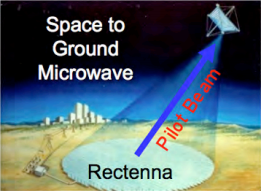 Space to ground microwave, laser pilot beam
(License: Public Domain, Author: Nasa]: Wikicommons
Space to ground microwave, laser pilot beam
(License: Public Domain, Author: Nasa]: Wikicommons Why don’t we just launch these cool satellites right away?
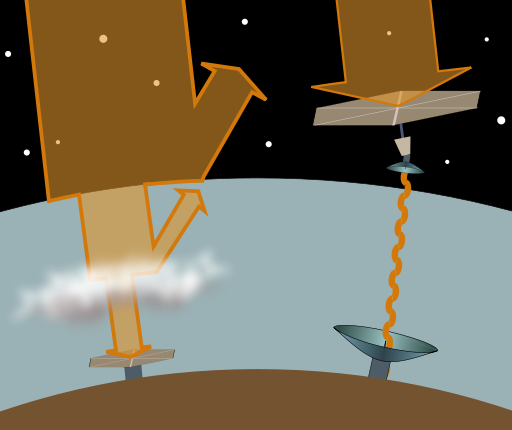 Terrestrial Solar panel system on left hindered by clouds vs SBSP transmission on the right, unhindered
(License: CC BY-SA 4.0, Author: Chabacano]: Wikicommons
Terrestrial Solar panel system on left hindered by clouds vs SBSP transmission on the right, unhindered
(License: CC BY-SA 4.0, Author: Chabacano]: Wikicommons The cost of setting up facilities in outer space has always been a major challenge to space-based projects. The cost of setting up a 10-25 MW SBSP prototype in low earth orbit was estimated to be around 200 million dollars. This is excluding service and maintenance cost. Paul Jaffe of the US Naval Research Laboratory estimated that $10 billion would be required to set up a demo orbital power station that would power about 150,00 homes within 10 years. 320 billion dollars has been projected to implement this technology to supply the energy demands of the whole United States till 2030. Let’s face reality here; THESE NUMBERS ARE SCARY! This is the reason why there seem to be a lack of enthusiasm and commitment on the part of governments to invest in the project. In Yasuyuki Fukumuro of JAXA’s interview, he suggested that collaboration between different nations would be needed to get a realistic chance of implementing the project as the cost would be too enormous for Japan to implement independently.
From a technical perspective, a significant fraction of transmitted energy (55–60%) is lost on its way through the Earth's atmosphere to the receiving ground station. Of the number that gets to the earth, about 10-40% is also lost due to the power conversion efficiency of the rectenna ranging from 60-90%. There are also safety issues associated with the transmission of laser beams and microwave through the earth’s atmosphere and as such, modulation of the wave’s energy would be required to prevent harm to any flying object that might wander in the beam’s path.
Looking Forward!
It’s about 50 years on since that initial idea of solar energy from space by Paul Glaser came into being and it’s still looking as though it is a near impossible task to achieve. Well, same was said about the aeroplane, the internet and many other wonderful inventions that have shaped the way we live today. As such, the possibilities of us experiencing the SBSP in this lifetime can never be ruled out, considering it has been theoretically proven and has made considerable practical progress since that 1968. From the marvels I’ve seen science and technology achieve in the little time I’ve spent with you guys on earth so far, talking from wireless communication, to microcontrollers, to nanotechnology, and to HBO's Game of Thrones… yes - Game of Thrones! I’d be damned to rule out anything anytime soon.
REFERENCES
Solar energy technology basis. Retrieved on June 3rd, 2018
How do solar panels work? Retrieved on June 4th, 2018
NASA wants to collect Solar Power directly from space. Retrived on June 4th, 2018
An Introduction to Harvesting Solar Energy from Space. Retrieved on June 4th, 2018
Space island group. Retrieved on June 4th, 2018
Practical application of space-based solar power generation. Retrieved on June 4th, 2018
Future visions: Space-based solar power. Retrieved on June 4th, 2018
Space based Solar power. Retrieved on June 4th, 2018
What It Will Take to Farm Sunlight from Space? Retrieved on June 4th, 2018
Wireless Power Transfer. Retrieved on June 4th, 2018
This is a good post entirely, but it bothers me that you mentioned Joshua as somebody who is noted 'in recorded history' to have lengthened the day - unless it was meant as tongue-in-cheek.
I don't mind people having whatever beliefs of course, but this kind of undermines the rest of the post as a legitimate scientific source. There's of course no way that there is real recorded documentation of a day on earth being extended - though there might be some interesting phenomenon out there that gave this illusion that might be worth a look into.
Anyway, otherwise very enlightening, cheers!
I understand the angle you are coming from @Mobbs and I have taken off that statement from my post.
Thanks for stopping by to read and sharing your thoughts in a professional manner.
Btw you were featured in the latest distilled @writeit. Congrats!
Yes and it was a great honour! I hope to keep improving on here. Thank you @terrylovejoy
Over the past few years, I've noticed more and more solar panels on roofs and in fields. I'd be very interested to know how fast they're being adopted nowadays and whether the adoption rate is expected to increase with increasing efficiency.
Excellent article man. I’m so ecstatic about harnessing the potentials SBSP has to offer. Let’s see what the future holds. I know it can only get better :D

Yes boss! With Nanotechnology we could overcome those barriers in the near future. Thanks for stopping by to read.
If anyone is interested, there a nice little scifi book, Powersat, by Ben Bova in which a startup trying to create the first commercial orbital power farm is featured.
Congratulations @writeit! You have completed some achievement on Steemit and have been rewarded with new badge(s) :
Click on the badge to view your Board of Honor.
If you no longer want to receive notifications, reply to this comment with the word
STOPHi @writeit!
Your post was upvoted by utopian.io in cooperation with steemstem - supporting knowledge, innovation and technological advancement on the Steem Blockchain.
Contribute to Open Source with utopian.io
Learn how to contribute on our website and join the new open source economy.
Want to chat? Join the Utopian Community on Discord https://discord.gg/h52nFrV
This is a really good post. I live in 'Solar Central' Arizona. We have thousands of acres of PV and CSP projects right close by. Space based is a pretty exciting prospect.
I'd like to invite you to join the Adsactly Discord room, which would make this post eligible for The Post Of The Day award. https://discord.gg/Ky7rjF
Glad you enjoyed the post. Those acres could be used for other things if we would just set up the panels in space instead.
Thanks for the invite.
Specifically here, in this little corner of heaven, the acres really can't be used for anything else unless you can figure out a way to wring more water out of the Colorado River.
But not even remotely implying that we shouldn't pursue the space based option.
Congratulations @writeit! You have completed some achievement on Steemit and have been rewarded with new badge(s) :
Click on the badge to view your Board of Honor.
If you no longer want to receive notifications, reply to this comment with the word
STOPCongratulations @writeit! You have completed some achievement on Steemit and have been rewarded with new badge(s) :
Click on the badge to view your Board of Honor.
If you no longer want to receive notifications, reply to this comment with the word
STOPgreat post bro, looking forward to your next article man.@writeit
